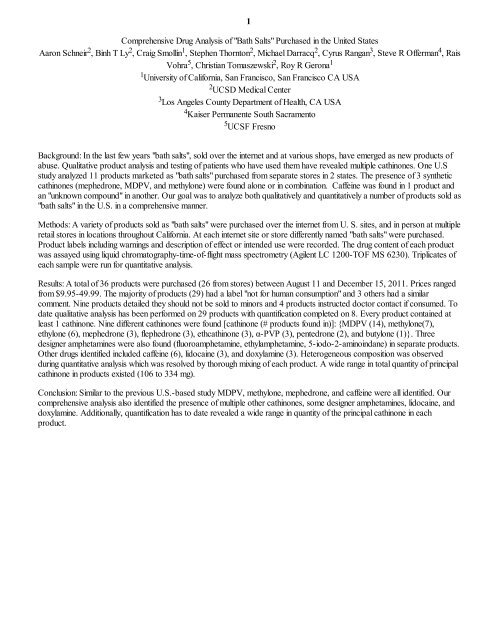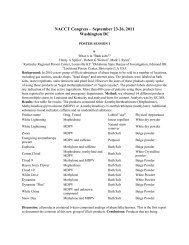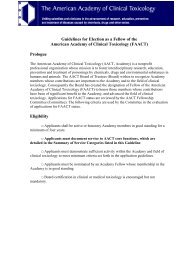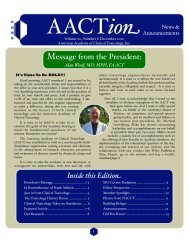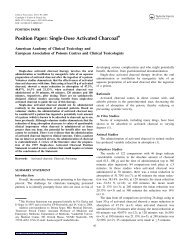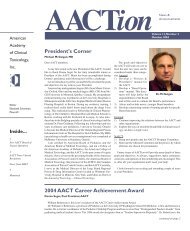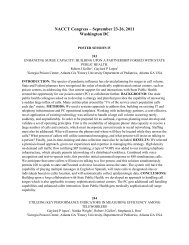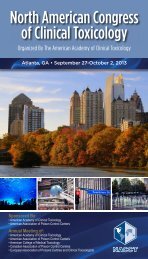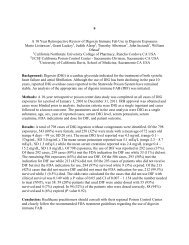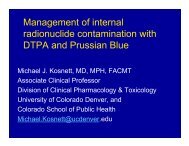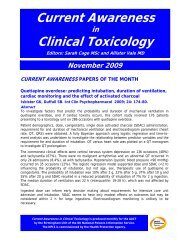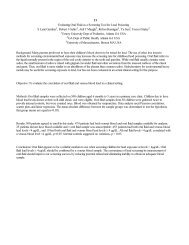NACCT Platform Abstracts 2012 - The American Academy of Clinical ...
NACCT Platform Abstracts 2012 - The American Academy of Clinical ...
NACCT Platform Abstracts 2012 - The American Academy of Clinical ...
Create successful ePaper yourself
Turn your PDF publications into a flip-book with our unique Google optimized e-Paper software.
1<br />
Comprehensive Drug Analysis <strong>of</strong> "Bath Salts" Purchased in the United States<br />
Aaron Schneir 2 , Binh T Ly 2 , Craig Smollin 1 , Stephen Thornton 2 , Michael Darracq 2 , Cyrus Rangan 3 , Steve R Offerman 4 , Rais<br />
Vohra 5 , Christian Tomaszewski 2 , Roy R Gerona 1<br />
1 University <strong>of</strong> California, San Francisco, San Francisco CA USA<br />
2 UCSD Medical Center<br />
3 Los Angeles County Department <strong>of</strong> Health, CA USA<br />
4 Kaiser Permanente South Sacramento<br />
5 UCSF Fresno<br />
Background: In the last few years "bath salts", sold over the internet and at various shops, have emerged as new products <strong>of</strong><br />
abuse. Qualitative product analysis and testing <strong>of</strong> patients who have used them have revealed multiple cathinones. One U.S<br />
study analyzed 11 products marketed as "bath salts" purchased from separate stores in 2 states. <strong>The</strong> presence <strong>of</strong> 3 synthetic<br />
cathinones (mephedrone, MDPV, and methylone) were found alone or in combination. Caffeine was found in 1 product and<br />
an "unknown compound" in another. Our goal was to analyze both qualitatively and quantitatively a number <strong>of</strong> products sold as<br />
"bath salts" in the U.S. in a comprehensive manner.<br />
Methods: A variety <strong>of</strong> products sold as "bath salts" were purchased over the internet from U. S. sites, and in person at multiple<br />
retail stores in locations throughout California. At each internet site or store differently named "bath salts" were purchased.<br />
Product labels including warnings and description <strong>of</strong> effect or intended use were recorded. <strong>The</strong> drug content <strong>of</strong> each product<br />
was assayed using liquid chromatography-time-<strong>of</strong>-flight mass spectrometry (Agilent LC 1200-TOF MS 6230). Triplicates <strong>of</strong><br />
each sample were run for quantitative analysis.<br />
Results: A total <strong>of</strong> 36 products were purchased (26 from stores) between August 11 and December 15, 2011. Prices ranged<br />
from $9.95-49.99. <strong>The</strong> majority <strong>of</strong> products (29) had a label "not for human consumption" and 3 others had a similar<br />
comment. Nine products detailed they should not be sold to minors and 4 products instructed doctor contact if consumed. To<br />
date qualitative analysis has been performed on 29 products with quantification completed on 8. Every product contained at<br />
least 1 cathinone. Nine different cathinones were found [cathinone (# products found in)]: {MDPV (14), methylone(7),<br />
ethylone (6), mephedrone (3), flephedrone (3), ethcathinone (3), α-PVP (3), pentedrone (2), and butylone (1)}. Three<br />
designer amphetamines were also found (fluoroamphetamine, ethylamphetamine, 5-iodo-2-aminoindane) in separate products.<br />
Other drugs identified included caffeine (6), lidocaine (3), and doxylamine (3). Heterogeneous composition was observed<br />
during quantitative analysis which was resolved by thorough mixing <strong>of</strong> each product. A wide range in total quantity <strong>of</strong> principal<br />
cathinone in products existed (106 to 334 mg).<br />
Conclusion: Similar to the previous U.S.-based study MDPV, methylone, mephedrone, and caffeine were all identified. Our<br />
comprehensive analysis also identified the presence <strong>of</strong> multiple other cathinones, some designer amphetamines, lidocaine, and<br />
doxylamine. Additionally, quantification has to date revealed a wide range in quantity <strong>of</strong> the principal cathinone in each<br />
product.
2<br />
<strong>The</strong> Epidemiology <strong>of</strong> Mushroom Ingestion Calls to US Poison Control Centers: 2001-2011<br />
Benjamin W Hatten 1 , Nathanael J McKeown 1 , Robert G Hendrickson 1 , B Zane Horowitz 1<br />
1 Oregon Health and Science University, Oregon Poison Center, Department <strong>of</strong> Emergency Medicine, Portland OR<br />
Background: <strong>The</strong>re have been neither national multiyear analyses <strong>of</strong> mushroom ingestions handled by poison control centers<br />
(PCCs), nor spatial analyses <strong>of</strong> these ingestions.<br />
Objectives: To describe the epidemiology <strong>of</strong> mushroom ingestion calls to PCCs. To perform a GIS/Spatial Epidemiology<br />
analysis <strong>of</strong> mushroom ingestion calls.<br />
Methods: A retrospective analysis <strong>of</strong> PCC call data. NPDS database search was performed, from 2001-2011 with matching<br />
mushroom codes. Demographics, toxin group, specific species ingested, clinical outcome, treatment location, and caller zip<br />
code were identified. Descriptive analysis was performed with Excel and Stata; Spatial analysis was performed with SaTScan<br />
and ArcGIS.<br />
Results: 83140 mushroom ingestions were reported to US PCCs from 2001-2011. 64534 (77.6%) were pediatric ingestions<br />
and 48437 (58.3%) were under 6 years old. 48423 (58.2%) <strong>of</strong> patients were male. 65255 (78.5%) <strong>of</strong> ingestions were<br />
unintentional. Identification was made in only 4232 (5.1%) exposures and included 185 distinct species. <strong>The</strong> 5 most common<br />
species (number <strong>of</strong> identifications): 1. Morchella angusticeps (507) 2. Chlorophyllum molybdites (374) 3. Amanita muscaria<br />
(319) 4. Lycoperdon candidum (228) 5. Calvatia lepidophora (175). <strong>The</strong> toxin group was identified in 12147 (14.6%) <strong>of</strong><br />
ingestions. <strong>The</strong> toxin groups (number <strong>of</strong> identifications) were: 1. Cyclopeptides (512) 1a. Orellanine (41) 2. Muscimol<br />
(Ibotenic Acid) (480) 3. Monomethylhydrazine (MMH) (448) 4. Muscarine and Histamine (284) 5. Coprine (141) 6.<br />
Hallucinogenics (Psilocybin and Psilocin) (8375). 7. Gastrointestinal Irritants (1866). Of the symptomatic cases, effects were<br />
minor in 10953 (56.5%), moderate in 7804 (40.3%), major in 568 (2.9%), and death in 45 (0.2%). Of the 614 cases <strong>of</strong><br />
major effect or death, a species was identified in 64 (10.4%). <strong>The</strong> 5 most common species (number <strong>of</strong> cases) identified as<br />
responsible for major effects or death were: Amanita phalloides (27), Amanita muscaria (22), Amanita pantherina (9), Amanita<br />
Smithiana/Proxima/Pseudoporphyria (5), & Amanita bisporigera (3). Of the 97 cases where Amanita phalloides was identified,<br />
23 (23.7%) resulted in major effects and 4 (4.1%) in death. In the 59 cases <strong>of</strong> Amanita phalloides ingestions where clinical<br />
effects were confirmed, 23 (39.0%) resulted in major effects and 4 (6.8%) in death. Maps demonstrating ingestion broken<br />
down by species <strong>of</strong> interest, toxin group, and clinical effects will be presented.<br />
Conclusions: Calls to US PCCs regarding mushroom ingestions occur commonly. However, the mushroom species or toxin<br />
group is infrequently identified. Major effects or death are rare, but symptomatic Amanita phalloides ingestions appear to be at<br />
the highest risk.
3<br />
DIGLYCOLIC ACID, THE NEPHROTOXIC METABOLITE OF DIETHYLENE GLYCOL, PRODUCES<br />
CYTOXICITY VIA MOLECULAR MIMICRY AND METABOLIC DISRUPTION<br />
Greg Landry 1 , Cody Dunning 1 , Kenneth McMartin 1<br />
1 LSU Health Sciences Center - Shreveport, Shreveport LA USA<br />
Background: Diethylene glycol (DEG) is an organic solvent used in antifreeze blends, brake fluid, and the production <strong>of</strong><br />
various polymers allowing the risk <strong>of</strong> consumer exposure. <strong>The</strong> hallmark <strong>of</strong> DEG poisoning is acute renal failure caused by<br />
cortical tubular degeneration and proximal tubule necrosis. DEG is metabolized to two primary metabolites, 2-<br />
hydroxyethoxyacetic acid (2-HEAA) and diglycolic acid (DGA). <strong>The</strong> main hypothesis <strong>of</strong> this study is that DGA produces<br />
proximal tubule cell necrosis seen in DEG poisoning via a molecular mimicry mechanism leading to metabolic disruption, and<br />
ultimately mitochondrial dysfunction. Methods: For transporter inhibition studies, confluent cells were incubated with N-(pamylcinnamoyl)anthranilic<br />
acid (ACA), a sodium dicarboxylate transporter (NaDC-1) inhibitor or 2,3-dimethylsuccinate (2,3-<br />
DMS), an NaDC-3 inhibitor, and increasing concentrations <strong>of</strong> DGA (0-100 mmol/L) for 48 h. Necrotic cell death was<br />
measured via ethidium homodimer uptake. Oxygen consumption was determined in whole cells using a standard Clark-type<br />
electrode in cells pre-treated with DGA for 6 h. ATP levels were determined using luciferase-coupled bioluminescence at<br />
various time points (0-36 h). Reactive oxygen species formation from 0-12 h was detected by the conversion <strong>of</strong><br />
dihydrorhodamine to the fluorescent product rhodamine 123. Succinate dehydrogenase (SDH) and fumarase activities were<br />
measured spectrophotometrically using purified enzyme in the presence <strong>of</strong> increasing DGA concentrations. Results: ACA, but<br />
not 2,3-DMS, decreased the degree <strong>of</strong> DGA-induced cell death by approximately 50% suggesting a specific role <strong>of</strong> NaDC-1<br />
in DGA intracellular uptake. DGA decreased oxygen consumption by approximately 30% in DGA-pretreated cells compared<br />
to controls. This effect corroborated the severe DGA-induced ATP depletion seen at 36 h, which most likely resulted from<br />
decreased oxidative phosphorylation in the mitochondria. DGA significantly decreased SDH activity at 50 and 100 mmol/L,<br />
but had no effect on fumarase activity suggesting the ability <strong>of</strong> DGA to mimic succinate, but not fumarate or L-malate. DGA<br />
also produced a concentration and time dependent increase in total cellular oxidant production indicating disruption <strong>of</strong> cellular<br />
redox status. Conclusions: <strong>The</strong>se results indicate that after internalization, DGA likely induces proximal tubule cell dysfunction<br />
by specific mitochondrial-mediated processes, which lead to decreased energy production and ultimately cellular necrosis.
4<br />
Investigation <strong>of</strong> an outbreak <strong>of</strong> photokeratitis.<br />
Jennifer Sears 2 , Naomi Mirowitz 2 , Steve Alles 2 , Kevin Osterhoudt 1 , Sara H Brower 1 , Jeanmarie Perrone 3<br />
1 <strong>The</strong> Poison Control Center at the Childrens Hospital <strong>of</strong> Philadelphia, Phila PA USA<br />
2 Philadelphia Department <strong>of</strong> Health, Phila PA USA<br />
3 Perelman School <strong>of</strong> Medicine at the University <strong>of</strong> Pennsylvania, Philadelphia PA USA<br />
BACKGROUND: Photokeratitis and burns caused by ultraviolet (UV) radiation have been reported from damaged metal<br />
halide bulbs when the protective outer bulb casing is not intact. On December 5th, 2011, an emergency physician contacted<br />
the regional poison center after evaluating a cluster <strong>of</strong> 13 patients who had presented to her emergency department (ED) in the<br />
middle <strong>of</strong> the night with complaints <strong>of</strong> eye pain. <strong>The</strong> patients had attended the same high school event earlier that day but no<br />
common exposure could be identified. A medical toxicologist was consulted and surveillance for other patients in surrounding<br />
EDs was performed by the poison center CSPI. A Hazmat investigation was initiated. Ninety nine persons presented to area<br />
EDs and skin and eye decontamination was performed.<br />
METHODS: <strong>The</strong> Department <strong>of</strong> Public Health conducted an investigation to characterize the exposure and symptom history <strong>of</strong><br />
approximately 1,000 event attendees. IRB approval was not obtained because it was a public health investigation. City<br />
Police, Fire, and Health Departments completed an in-depth examination <strong>of</strong> the high school gymnasium, which included<br />
reviewing video footage and testing for hazardous chemicals. A web-based survey was distributed on December 7th to<br />
capture attendees' exposure and symptom history. A case was defined as a person with 2 or more acute eye symptoms who<br />
attended the competition.<br />
RESULTS: Surveys were completed by 760 persons, representing approximately 76% <strong>of</strong> attendees. Two hundred forty two<br />
(32%) respondents met the case definition. Acute eye symptoms among cases included burning eyes (96%), red eyes (89%),<br />
tearing eyes (82%), foreign body sensation (82%), blurry vision (57%), and eyelid swelling (51%). Of the 127 individuals who<br />
sought care, 99 (78%) went to EDs. <strong>The</strong> median time between arriving at the gym and symptom onset was 9 hours (range:<br />
5<br />
Poison center consultation and hospital length <strong>of</strong> stay<br />
Mark A Kostic 1 , David D Gummin 2 , Jessica Oswald 1<br />
1 Medical College <strong>of</strong> Wisconsin, Milwaukee WI USA<br />
2 Wisconsin Poison Center, Milwaukee WI USA<br />
Background: Poison Centers’ (PCs) impact on inpatient care is not easily quantified. While hard endpoints are elusive, the<br />
ability to measure and quantify value is increasingly relevant as competition for healthcare dollars intensifies. Hospital length <strong>of</strong><br />
stay (LOS) is an accepted metric that encompasses both cost and efficiency in healthcare facilities (HCFs). Reduced LOS<br />
may reflect “streamlined” care at lower cost and greater efficiency. But reduced LOS might also translate into reduced revenue<br />
opportunity for the treating HCF – not a popular concept in today’s market.<br />
Objective: Determine the impact <strong>of</strong> poison center consultation on hospital LOS and charges for poisoned or potentially<br />
poisoned hospital patients in one state.<br />
Methods: All hospitals within the PC’s designated region report billing and discharge coding data to the state Hospital<br />
Association (HA) database. Cases tabulated by the HA between 7/1/2008 and 6/30/2011 were directly matched against<br />
those within the PC case database. Included cases were hospitalized under an external cause <strong>of</strong> injury (E code) for poisoning.<br />
Exclusion criteria (psychiatric or rehab admissions, medical complications noted by certain ICD9 codes, adverse drug events)<br />
ensured that outliers were minimized and only cases hospitalized primarily for poisoning were included. “Matched” cases were<br />
found in both the PC and the HA databases during a specific hospitalization. “Unmatched” cases appeared only in the HA<br />
records (i.e. the PC was not consulted). Mean LOS and charges were compared between the groups. Payor status was also<br />
documented and tracked.<br />
Results:<br />
Mean LOS (days) for<br />
all cases<br />
Mean LOS (days) for<br />
age < 12 yrs<br />
Mean LOS (days) for<br />
age 12-18 yrs<br />
Mean LOS (days) for<br />
age > 18 yrs<br />
Mean Charges ($) for<br />
all cases<br />
Matched (95% CI) Unmatched (95% CI) Δ; p value<br />
2.42 (2.33,2.5) 2.87 (2.81,2.93) 0.45;
6<br />
Incidents <strong>of</strong> Public Health Significance identified by National Surveillance <strong>of</strong> Poison Center Data<br />
Sophia Sheikh 1 , Royal Law 1 , Alvin Bronstein 2 , Richard Thomas 2 , Henry Spiller 2 , Joshua Schier 1<br />
1 Centers for Disease Control and Prevention, Atlanta GA USA<br />
2 <strong>American</strong> Association <strong>of</strong> Poison Control Centers<br />
<strong>The</strong> Centers for Disease Control and Prevention and the <strong>American</strong> Association <strong>of</strong> Poison Control Centers conduct public<br />
health surveillance on data collected by the National Poison Data System (NPDS) to identify incidents <strong>of</strong> public health<br />
significance (PHS). Automated surveillance algorithms run continuously in NPDS to identify instances when the number <strong>of</strong><br />
hourly calls to a PC (call volume incidents or CVIs), or the daily, cumulative count <strong>of</strong> any reported sign, symptom, or<br />
laboratory abnormality (clinical effect incidents or CEIs) exceed a historical baseline. Incidents are reviewed daily by clinical<br />
toxicologists and epidemiologists to determine if an incident is <strong>of</strong> PHS and if further public health action is needed. <strong>The</strong><br />
objective <strong>of</strong> this report is to characterize incidents <strong>of</strong> PHS identified by national surveillance from 1/2007 to 8/2011. Methods:<br />
All incidents <strong>of</strong> PHS identified from 1/1/2007 to 8/1/2011 were reviewed. PHS was left to the individual judgment <strong>of</strong> the<br />
surveillance team member. Outcome measures for CVIs included mechanism <strong>of</strong> chemical exposure, setting, and substance<br />
type: mechanism <strong>of</strong> chemical exposure, clinical syndrome, specific illness and substance reported was reported for CEIs.<br />
Results: A total <strong>of</strong> 830 CVIs were identified and the majority were <strong>of</strong> PHS (n=721; 86.9%). Airborne exposures (e.g., gases<br />
and fumes) were the most reported mechanism <strong>of</strong> chemical exposure for each year, and in total (n=312; 42.2%). <strong>The</strong> most<br />
common exposure setting for all years when combined was occupational (n=128, 27.9%), followed by school (n=126,<br />
27.5%). <strong>The</strong> most frequently reported chemical exposure every year was carbon monoxide (n=115, 15.5%), except in 2007<br />
(when an outbreak <strong>of</strong> Salmonella contaminated peanut butter occurred). A cumulative total <strong>of</strong> 383 CEIs were identified and<br />
the majority were <strong>of</strong> PHS (n=339; 88.5%). Airborne exposures were the most common mechanism <strong>of</strong> exposure for all years<br />
combined (70, 21.8%), followed by product contamination/tampering (68, 19.7%). <strong>The</strong> most common syndrome reported<br />
was gastrointestinal (n=124, 20.9%); diarrhea was the most frequently reported illness (n=42, 7.1%). Contaminated peanut<br />
butter (2007 and 2009 outbreaks) was the most frequently reported substance overall (n=61, 18%). Conclusions: Carbon<br />
monoxide releases were the most frequently reported incidents <strong>of</strong> PHS and gastrointestinal syndromes and symptoms were the<br />
most commonly reported illness manifestations. Surveillance <strong>of</strong> NPDS data can be used to characterize incidents <strong>of</strong> PHS and<br />
possibly identify risk factors for future interventions. <strong>The</strong>se surveillance strategies can be replicated at the regional level which<br />
would be <strong>of</strong> interest to state health departments.
7<br />
Massive acetaminophen overdose treated with immediate hemodialysis: Is the antidote removed faster than the toxin?<br />
Marco L Sivilotti 1 , David N Juurlink 2 , Lauren Hanly 3 , Ilan Lenga 4 , Jocelyn S Garland 1 , Margaret Thompson 2<br />
1 Queen's University, Kingston ON Canada<br />
2 Ontario Poison Centre, Toronto ON Canada<br />
3 University <strong>of</strong> Western Ontario, London ON Canada<br />
4 Lakeridge Health, Oshawa ON Canada<br />
Background: <strong>The</strong> role <strong>of</strong> hemodialysis for acetaminophen (APAP) overdose is debated. While APAP (MW 151 daltons) is<br />
readily dialyzable, its antidote acetylcysteine (MW 163) is as well. We occasionally recommend hemodialysis when it can be<br />
started immediately for the rare patient with features <strong>of</strong> so-called "mitochondrial paralysis" (lactic acidosis, altered mental<br />
status, depressed catabolism) following massive APAP overdose. We prospectively measured serum acetylcysteine<br />
concentrations during hemodialysis in such cases.<br />
Case series: Three patients (ages 20 to 65 years) each presented unconscious after ingesting more than 60 grams <strong>of</strong> APAP.<br />
One coingested prednisone, another ibupr<strong>of</strong>en/chlorpheniramine/pseudoephedrine, and two were hypothermic (lowest 31.5ºC<br />
rectal). Serum lactate ranged from 7 to 12.5 mM (pyroglutamic acid not measured). Each was intubated, and initial APAP<br />
concentrations were as high as 5980 μM (900 μg/mL). Intravenous acetylcysteine was initiated between 10.8 and ~18 hours<br />
post ingestion, and hemodialysis ~4 hours later. While dosing regimens varied, all patients were empirically administered<br />
additional acetylcysteine to compensate for possible antidote removal during hemodialysis. In each case, a single course <strong>of</strong><br />
hemodialysis (duration 3.2 to 4.2 hours; blood flow ~ 400 mL/min) reduced serum APAP concentrations by 56 to 84% (mean<br />
elimination half-life 110 minutes), and also resulted in marked improvement with rapid resolution <strong>of</strong> the lactic acidosis. Serum<br />
acetylcysteine concentrations ranged from 220 to 1980 μM during hemodialysis, and the extraction ratio <strong>of</strong> acetylcysteine<br />
across the dialysis circuit ranged from 73% to 87%. All three patients recovered fully, with only one developing ALT > 1000<br />
IU/L, and none developing coagulopathy or other signs <strong>of</strong> liver failure.<br />
Case discussion: As expected, both APAP and acetylcysteine are effectively and rapidly cleared during hemodialysis. Based<br />
on the kinetics observed in this case series, we estimate that hemodialysis more than doubles the overall clearance <strong>of</strong><br />
acetylcysteine. Doubling the rate <strong>of</strong> the 4-hour component <strong>of</strong> the Prescott protocol to 25 mg/kg/hr, or administering<br />
intermittent doses <strong>of</strong> 70 mg/kg every 2 hours instead <strong>of</strong> every 4 hours, should help compensate for this removal.<br />
Conclusion: When massive APAP ingestion is accompanied by coma and lactic acidosis, immediate hemodialysis can result in<br />
rapid biochemical and clinical improvement. Recognizing that acetylcysteine dosing is largely empirical, we recommend that the<br />
dosing <strong>of</strong> acetylcysteine be at least doubled whenever patients being treated with acetylcysteine undergo hemodialysis.
8<br />
Effectiveness <strong>of</strong> low dose naloxone to reverse respiratory depression in opioid intoxication<br />
Hong K Kim 1 , Lewis S Nelson 1<br />
1 New York University School <strong>of</strong> Medicine, New York NY USA<br />
Background: Although naloxone reverses the respiratory and CNS effects <strong>of</strong> opioids, care must be utilized to avoid<br />
precipitating acute opioid withdrawal syndrome (OWS). <strong>The</strong> commonly recommended initial naloxone dose <strong>of</strong> 0.4 mg is<br />
based on studies in a non-opioid-dependent population undergoing anesthetic reversal. However, in opioid-dependent<br />
patients, this dose predictably results in acute withdrawal. Despite limited data demonstrating the efficacy <strong>of</strong> a lower dose <strong>of</strong><br />
naloxone, 0.04 mg is <strong>of</strong>ten recommended in medical toxicology and anesthesia texts as safe and effective. <strong>The</strong> objective <strong>of</strong> this<br />
study was to evaluate the clinical effects <strong>of</strong> naloxone 0.04 mg (with titration) on the respiratory depression noted in ED patients<br />
with acute opioid overdose.<br />
Methods: A prospective observational study <strong>of</strong> the current ED practice <strong>of</strong> naloxone use in opioid intoxicated patients was<br />
conducted. Thirty consecutive ED patients, 18 years and older, with clinical findings <strong>of</strong> opioid intoxication (e.g., history, CNS<br />
depression, pinpoint pupils, RR < 8/ minute) requiring naloxone were included. <strong>The</strong> primary outcome was improved RR.<br />
Secondary outcomes were end-tidal CO2 level (CO2), pulse oximetry (O2 sat) on room air, Richmond Agitation Sedation<br />
Scale (RASS), and OWS.<br />
Results: Preliminary results involving five ED patients are summarized in the table. All five patients experienced coma with<br />
hypoventilation due to methadone use. On average, patients required two naloxone doses <strong>of</strong> 0.04 mg. One patient (patient D)<br />
experienced acute OWS with a total naloxone dose <strong>of</strong> 0.08 mg.<br />
Table<br />
Patient A<br />
Patient B<br />
Patient C<br />
Patient D<br />
Patient E<br />
Drug history <strong>Clinical</strong> findings Naloxone (mg) <strong>Clinical</strong> response<br />
Methadone<br />
Methadone<br />
Benzodiazepine<br />
Methadone<br />
Methadone<br />
Methadone<br />
RR: 6/min<br />
RASS: -4<br />
O 2 sat: 87%<br />
CO 2 : 50 mmHg<br />
RR: 7/min<br />
RASS: -4<br />
O 2 sat: 95%<br />
CO 2 : NR<br />
RR: 6/min<br />
RASS: -5<br />
O 2 sat: 80%<br />
CO 2 : NR<br />
RR: NR<br />
RASS: -5<br />
O 2 sat: 40%<br />
CO 2 : 60 mmHg<br />
RR: 3/min<br />
RASS: -4<br />
O 2 sat: 92%<br />
CO 2 : 55 mmHg<br />
IV: 0.04 x 2<br />
IV: 0.04 x 3<br />
Infusion: 0.04 mg/hr<br />
IV: 0.04<br />
Infusion: 0.05 mg/hr<br />
IV: 0.04 x 2<br />
Infusion: 0.1 mg/hr<br />
IV: 0.04 x 2<br />
Infusion: 0.05 mg/hr<br />
RR: 14/min<br />
RASS: 2<br />
O 2 sat: 95%<br />
CO 2 : 42 mmHg<br />
RR: 9/min<br />
RASS: -1<br />
O2 sat: 99%<br />
CO 2 : NR<br />
RR: 12/min<br />
RASS: 0<br />
O 2 sat: 92%<br />
CO 2 : 29 mmHg<br />
RR: 13/min<br />
RASS: 2<br />
O 2 sat: 99%<br />
CO 2 : NR<br />
OWS: vomitting<br />
RR: 6/min<br />
RASS: -2<br />
O 2 sat: 94%<br />
CO 2 : 50 mmHg<br />
NR: not reported<br />
Conclusion: A naloxone dose <strong>of</strong> 0.04 mg with appropriate dose titration can effectively reverse both respiratory and CNS<br />
depression. A total dose <strong>of</strong> 0.08 mg may be required, but titration would limit the risk <strong>of</strong> acute OWS. Initial results indicate the<br />
commonly recommended initial dose <strong>of</strong> 0.4 mg may be excessive.
82<br />
Clonidine For Cuties: <strong>The</strong> Quick Fix in Neonatal Abstinence Syndrome<br />
Vinodinee L Dissanayake 1 , Prajakta Korde 3 , Karen M Kelly 3 , Hongyan Du 4 , Jerrold B Leikin 2<br />
1 Toxikon Consortium, Chicago IL USA<br />
2 NorthShore University HealthSytems-OMEGA, Glenview IL USA<br />
3 NorthShore University HealthSystems, Evanston IL USA<br />
4 NorthShore University HealthSystem Research Institute, Evanston IL USA<br />
Background<br />
Maternal drug abuse results in serious health consequences for the fetus, including neonatal abstinence syndrome (NAS). Poor<br />
feeding, autonomic instability and seizures make NAS a challenging condition; narcotic therapy complicates it further with CNS<br />
and respiratory depression and the need for long methadone tapers. Clonidine, an alpha agonist, has been used in young child<br />
and adult opiate withdrawal, but little data exists on its use as a primary agent to prevent NAS.<br />
Methods<br />
A retrospective chart review was conducted on neonates with NAS at Evanston Hospital (EH) <strong>of</strong> the NorthShore University<br />
HealthSystem from August 2007-July 2011. <strong>The</strong> EH neonatal intensive care unit <strong>of</strong>fers a NAS order set with clonidine (0.5-1<br />
mcg/kg every 6 hours) as the primary medication. <strong>The</strong> order set lists as-needed lorazepam and phenobarbital as adjuncts.<br />
Methadone is given on an individual basis. Pharmacotherapy is provided with modified Finnegan scores <strong>of</strong> 8 or above. Thirtyone<br />
charts were reviewed; 2 were excluded due to concomitant methadone and clonidine. From the remaining charts,<br />
demographic data, dose and duration <strong>of</strong> therapy, modified Finnegan scores, and adjunct therapy were recorded. A statistician<br />
used Chi-square testing, Fisher's exact testing and Wilcoxon two sample testing for statistical analysis.<br />
Results<br />
Out <strong>of</strong> 29 patients, 21 were given clonidine and 8 were given methadone by physician choice. None had seizures or adverse<br />
drug events. Gender, average gestational age in days (C: 33.43 vs. M: 29.25), and average weight in kg (C: 2.32 vs. M: 2.09)<br />
were not statistically different between groups (p>0.05). <strong>The</strong> duration <strong>of</strong> treatment in days was shorter with clonidine than<br />
methadone (C: 10.38 vs. M: 34.63, p=0.0008). <strong>The</strong> duration <strong>of</strong> adjunct therapy in days was shorter in the clonidine group (C:<br />
4.5 vs. M: 12, p=0.804). Also, clonidine use was associated with successful extubation rather than methadone (C: 83.3% vs.<br />
M: 16.7%, p=0.012). <strong>The</strong> minimum and maximum abstinence scores were higher with clonidine use (C: 2.95, 9.05 vs. M:<br />
0.94, 6.26, p=0.0484, 0.0426), yet efficacy <strong>of</strong> both treatments is evident by the virtual normalization <strong>of</strong> modified Finnegan<br />
scores by the end <strong>of</strong> treatment (C: 3.64, M: 2.44, p=0.270).<br />
Conclusions<br />
This study demonstrates that clonidine can be safely and successfully used as a primary agent without a narcotic in the<br />
prevention <strong>of</strong> NAS. Clonidine required shorter treatment duration, as well as shorter adjunct therapy duration than methadone.<br />
Home therapy was avoided with the use <strong>of</strong> clonidine. With its use, neonates experienced a similar 60% drop in modified<br />
Finnegan scores as the methadone group. Larger studies are needed to determine whether these results are reproducible in<br />
other populations.
83<br />
Passive Multi-state Surveillance for Levamisole-associated Neutropenia in Cocaine or Heroin Users<br />
Sara J Vagi 1 , Sophia Sheikh 1 , Monica Brackney 2 , Susan Smolinske 3 , Brandon Warrick 3 , Nicholas Reuter 4 , Joshua G Schier 1<br />
1 CDC, Atlanta GA USA<br />
2 New Mexico Department <strong>of</strong> Health, Santa Fe NM USA<br />
3 Childrens Hospital <strong>of</strong> Michigan, Regional Poison Center, Detroit MI USA<br />
4 U.S. Substance Abuse and Mental Health Services Administration, Rockville MD USA<br />
Background/Objectives: Numerous reports describe patients with agranulocytosis after using levamisole-contaminated<br />
cocaine (LCC). We conducted surveillance to characterize the demographic, clinical and epidemiologic features <strong>of</strong> levamisoleassociated<br />
neutropenia in cocaine or heroin users.<br />
Method: Multi-state, passive surveillance was conducted between October 15, 2009 and May 31, 2010. State health<br />
departments (HDs) were recruited for participation when CDC was notified <strong>of</strong> suspected cases by a clinician, a HD <strong>of</strong>ficial or<br />
from a poison center. A probable case was defined as an adult (>18 years) with neutropenia (absolute neutrophil count <<br />
1000 cells/mL or white blood cell count < 2000 cells/mL) and either self-reported cocaine or heroin use in the past month, or<br />
detection <strong>of</strong> cocaine in urine. A confirmed case was a probable case with detection <strong>of</strong> levamisole in urine. Health department<br />
<strong>of</strong>ficials abstracted data on suspected cases, attempted a patient interview and submitted demographic, epidemiological and<br />
clinical data to CDC for descriptive analysis.<br />
Results: Forty-one data abstraction forms were received by CDC; sixteen (40%) did not meet eligibility criteria and were<br />
excluded. Of the 25 remaining cases used in the analysis, 24 were probable cases and one was confirmed. <strong>The</strong>se cases<br />
represented Michigan (n=14; 56%), New Mexico (n=10; 40%), and one from Minnesota (4%). Ten (40%) completed<br />
interviews administered by local or state HD personnel. <strong>The</strong> average age was 44.6 years and half were male (n=13; 52%).<br />
Half presented with infectious illnesses (n=13; 52%), and two-thirds reported active skin lesions (n=17; 68%). Five included<br />
descriptions: necrotic (n=3) and ulcerative (n=2). <strong>The</strong> majority <strong>of</strong> interview respondents used cocaine > 2-3 times a week<br />
(n=9; 90%). More than half used cocaine > 2 years (n=6; 60%), smoked it (n=7; 70%), and preferred crack cocaine (n=6;<br />
60%). All were unaware <strong>of</strong> exposure to LCC and <strong>of</strong> levamisole’s inherent toxicity (n=10; 100%). No unique attributes<br />
differentiating an experience with LCC from a non-LCC experience were identified through chart review or interview.<br />
Conclusions: Levamisole-associated neutropenia from cocaine use is an emerging public health issue. Most cases reported<br />
chronic, long-term cocaine use and were unaware <strong>of</strong> levamisole exposure. Cocaine use is more prevalent among males,<br />
however, this and other studies looking at neutropenia in LCC users have found an equal or higher proportion <strong>of</strong> females<br />
suggesting females may be at higher risk. Physicians should suspect exposure to levamisole-contaminated recreational drugs<br />
when treating persons with a history <strong>of</strong> cocaine use presenting with unexplained neutropenia.
84<br />
Adjunct Ketamine Use in the Management <strong>of</strong> Severe Alcohol Withdrawal: A Case Series<br />
Nathan Menke 1 , andrew king 1 , kenneth katz 1 , michael lynch 1 , michael abesamis 1 , anthony pizon 1<br />
1 University <strong>of</strong> Pittsburgh Medical Center, pittsburgh PA USA<br />
Background: Abrupt cessation <strong>of</strong> chronic ethanol abuse can result in a prolonged hyperexcitable state due to prolonged<br />
antecedent GABA-A desentization/downregulation. Historically, patients in delirium tremens require ICU-level care, large<br />
doses <strong>of</strong> benzodiazepines, receive intubation in severe cases, and have a prolonged hospitalization with tapering doses <strong>of</strong><br />
benzodiazepines. In addition to its GABA agonist properties, ethanol also functions as an NMDA antagonist; thus,chronic<br />
alcoholism results in concomitant upregulation <strong>of</strong> NMDA receptors. Use <strong>of</strong> an NMDA receptor antagonist <strong>of</strong>fers a biologically<br />
plausible adjunctive therapy that may decrease the total GABA agonist dose utilized for treatment <strong>of</strong> chronic alcohol<br />
withdrawal.<br />
Case Series:<br />
We instituted a protocol <strong>of</strong> intravenous ketamine administration (10 mg / hour) for patients in severe alcohol withdrawal (AW)<br />
as diagnosed by a board certified medical toxicologist. <strong>The</strong> ketamine infusion was continued until delirium resolved. All patients<br />
defined as severe alcohol withdrawal required greater than 100 mg diazepam in less than 24 hours (or equivalent<br />
benzodiazepine) and ICU admission.<br />
Our series included a total <strong>of</strong> 8 patients (7 men, 1 woman). Table I contains age, sex, ICU length <strong>of</strong> stay, and number <strong>of</strong> days<br />
<strong>of</strong> ketamine infusion. None <strong>of</strong> the patients required intubation.<br />
Table I: Patient Characteristics<br />
Sex<br />
Age<br />
(Years<br />
ICU<br />
(Days)<br />
M 52 3 1.5<br />
M 45 5 2.5<br />
M 49 5.5 2<br />
M 51 4 1.5<br />
F 57 4 3<br />
M 52 4 4<br />
M 33 8 5<br />
M 55 5 2<br />
Ketamine<br />
(Days)<br />
Discussion:<br />
<strong>The</strong> addition <strong>of</strong> ketamine to standard GABA agonist therapy is theoretically beneficial due to its NMDA antagonist properties.<br />
Historically, the use <strong>of</strong> ketamine is safe, well tolerated, and with minimal adverse effects. <strong>The</strong> results <strong>of</strong> this initial case series<br />
are promising for the use <strong>of</strong> adjunctive ketamine in severe AW. Overall ICU length <strong>of</strong> stay and GABA agonist requirements<br />
were less than anticipated given the severity <strong>of</strong> the patients' alcohol withdrawal (based on the judgment <strong>of</strong> experienced<br />
toxicologists).We hypothesize that the addition <strong>of</strong> an NMDA antagonist will: 1) decrease the amount <strong>of</strong> GABA agonist<br />
required for sedation, 2) decrease length <strong>of</strong> stay in the ICU, and 3) prevent intubation. Follow-up studies will be required to<br />
determine the true utility <strong>of</strong> ketamine in severe AW. <strong>The</strong>se will include dose response curves, randomization <strong>of</strong> patients to<br />
treatment arms, and blinding <strong>of</strong> providers to therapies.<br />
Conclusions: Based on this descriptive case series, one center has had good success using ketamine in cases <strong>of</strong> severe AW.<br />
Adjunctive ketamine infusions can be considered for patients in severe AW requiring large initial doses <strong>of</strong> parenteral<br />
benzodiazepines that require ICU level <strong>of</strong> care.
85<br />
Botulism outbreak in a state prison from "pruno"<br />
Ben T Williams 1 , Sarah Schlein 1 , Martin Caravati 1 , Benjamin Hatten<br />
1 University <strong>of</strong> Utah, Salt Lake City UT USA<br />
Background: Outbreaks <strong>of</strong> botulism in the US are very rare. We report a large outbreak <strong>of</strong> botulinum poisoning in a prison<br />
population after ingestion <strong>of</strong> homemade "wine". Methods: This is an observational case series identified by a sentinel case in an<br />
ED. Data was obtained from bedside exams and medical record reviews. Results: <strong>The</strong> sentinel case arrived in the ED 52 hours<br />
after ingestion <strong>of</strong> a homemade alcoholic beverage (pruno) complaining <strong>of</strong> diplopia, dysarthria, fatigue, and dysphagia. At least<br />
11 more prisoners subsequently admitted to consuming pruno. Eight patients consumed the first batch <strong>of</strong> pruno, which<br />
contained a rotten potato and four patients consumed the second batch, which did not contain a potato. Two <strong>of</strong> the 4 patients<br />
from the second batch <strong>of</strong> pruno were evaluated in the ED while the other 2 patients were evaluated by a neurologist via<br />
telemedicine. None <strong>of</strong> these prisoners were admitted to the hospital but were observed in the prison infirmary. For the 8<br />
patients who consumed the first batch <strong>of</strong> pruno, the mean onset <strong>of</strong> symptoms after ingestion was 75.5 hours. Initial symptoms<br />
included: dysphagia (5pts), diplopia (4 pts), dysarthria (3pts) and general weakness (3pts). All 8 <strong>of</strong> these patients were<br />
admitted to the ICU for monitoring and received antitoxin an average <strong>of</strong> 96 hrs after exposure. Seven <strong>of</strong> these 8 patients had<br />
positive stool samples for botulinum toxin. Three patients developed respiratory failure and were intubated. <strong>The</strong> 5 patients who<br />
did not require intubation had a mean Negative Inspiratory Force (NIF) <strong>of</strong> -58 cm H2O (range, -50 to -60) and a FVC <strong>of</strong><br />
4.36L range, 3.25 – 4.7). <strong>The</strong> 3 patients who required intubation had an average NIF <strong>of</strong> -35 cm H2O (range, -15 to -60) and<br />
FVC <strong>of</strong> 3L (range, 0.9 t 4.7). All 8 patients had an EMG, which was abnormal in 1 <strong>of</strong> 5 non-intubated patients and in 2 <strong>of</strong> 3<br />
intubated patients. Seven <strong>of</strong> 8 hospitalized patients had persistent symptoms 2 months post-ingestion. <strong>The</strong> 3 intubated patients<br />
had a slower recovery with 2 requiring tracheostomy and PEG tube placement. <strong>The</strong>se 2 patients required prolonged inpatient<br />
stay in the rehabilitation unit and developed other complications associated with the exposure. <strong>The</strong>y had removal <strong>of</strong><br />
tracheostomy and PEG at 51 and 90 days post-ingestion. Discussion: Ingestion <strong>of</strong> "pruno" at a state prison resulted in one <strong>of</strong><br />
the largest isolated outbreaks <strong>of</strong> botulism in the US within the last 10 years.
159<br />
A Spoonful <strong>of</strong> Cinnamon: <strong>The</strong> "Cinnamon Challenge" - Google Trends and the National Poison Data System<br />
C M Deutsch 1 , A C Bronstein 1 , D A Spyker 2<br />
1 Rocky Mountain Poison & Drug Center - Denver Health, Denver CO USA<br />
2 Uniformed Services University <strong>of</strong> the Health Sciences, Bethesda MD USA<br />
Background: <strong>The</strong> "cinnamon challenge" is a popular dare in which a person attempts to swallow a tablespoon <strong>of</strong> ground<br />
cinnamon without water in under 60 seconds. News reports <strong>of</strong> the challenge surfaced in 2001 with popularity peaking in<br />
January <strong>2012</strong>. This challenge is <strong>of</strong>ten videoed and uploaded to social media websites. Serious health consequences can result.<br />
Articles, including an AAPCC press release (28 March <strong>2012</strong>), warning <strong>of</strong> health risks emerged in early March <strong>2012</strong>. <strong>The</strong><br />
National Poison Data System (NPDS) <strong>of</strong> the <strong>American</strong> Association <strong>of</strong> Poison Control Centers (AAPCC) aggregates near<br />
real-time human exposure data from the 57 US poison centers. Google Trends (GT) provides the relative frequency <strong>of</strong> topic<br />
searches over time and correlates the search frequency with news reports. Limited studies have explored the promise <strong>of</strong><br />
internet search system results being used to predict public health events. We looked at the predictive capabilities <strong>of</strong> both<br />
systems for this popular dare.<br />
Methods: We examined the time based (secular) trends in Cinnamon Exposures reported to NPDS and Google Trends<br />
(Cinnamon, Cinnamon Challenge) by week (4 January 2004- 8 April <strong>2012</strong>) using change over time pr<strong>of</strong>iles and correlation<br />
coefficients.<br />
Results: Weekly NPDS call volumes ranged from 0-15 for the time period <strong>of</strong> 2004-2011. In <strong>2012</strong>, the range was 4-49, with<br />
the peak <strong>of</strong> 49 occurring the week <strong>of</strong> 29 January <strong>2012</strong>. GT queries for cinnamon and cinnamon challenge demonstrated a<br />
similar pattern over the years with GT searches peaking the same week. Activity for both NPDS and GT started to increase<br />
33 weeks ago (21 August 2011-8 April <strong>2012</strong>), with volumes tripling. During this time period, weekly GT volumes were each<br />
highly correlated with NPDS calls [GT Cinnamon: r-square = 0.624; GT Cinnamon Challenge: r-square= 0.820; and GT<br />
Cinnamon + Cinnamon Challenge: r-square= 0.761; with a p
160<br />
Comparison <strong>of</strong> exposure fatalities from the medical examiner's <strong>of</strong>fice and the poison center<br />
Suzanne Doyon 1 , David Fowler 2<br />
1 University <strong>of</strong> Maryland School <strong>of</strong> Pharmacy Maryland Poison Center, Baltimore MD USA<br />
2 Office <strong>of</strong> the Chief Medical Examiner, Baltimore MD USA<br />
Introduction: <strong>The</strong> Office <strong>of</strong> the Chief Medical Examiner (OCME) play a critical role in investigating exposure deaths. In<br />
2010, a collaboration between the OCME and the Maryland Poison Center was started. <strong>The</strong> type <strong>of</strong> fatal exposure most<br />
likely to be reported to the poison center has not been studied.<br />
Purpose: Determine and characterize the exposure deaths investigated by the OCME and reported and not reported to the<br />
poison center.<br />
Methodology: A query <strong>of</strong> the OCME database from January 1 2011 to December 31 2011 (12 months) was performed<br />
using query words that would identify all exposures fatalities. Demographic information including all zip codes, site <strong>of</strong> death,<br />
cause <strong>of</strong> death, manner <strong>of</strong> death, complete toxicologic analysis and field notes were obtained.<br />
Results: A total <strong>of</strong> 810 poisoning fatalities were examined over a 12-month period. Four hundred ninety (61%) died prehospital;<br />
320 (39%) died in hospital. Of these, 229 died in the emergency department (ED) after presenting in cardiac arrest<br />
without return <strong>of</strong> spontaneous circulation and 91 died after being admitted to the hospital. Comparison <strong>of</strong> the 91 hospitalized<br />
exposure deaths is found in Table 1. Twenty six deaths were captured and 65 were not captured by the poison center. <strong>The</strong>re<br />
were 5 hospitalized fatalities in children under 18 years <strong>of</strong> age. <strong>The</strong> poison center captured 3 but did not capture one 13 yo<br />
burn victim and one 17 yo heroin overdose.<br />
Table 1. Hospitalized exposure deaths captured and not captured by the poison center.<br />
Reason for<br />
exposure<br />
Captured cases<br />
n=26 (%)<br />
Noncaptured cases and causes <strong>of</strong> death n=65 (%)<br />
Suicide 9 (60) 6 (40): carisoprodol 1; DoA 3; metoprolol 1; APAP 1<br />
Misuse/abuse 9 (18)<br />
Unknown 4 (33) 8 (66): DoA 7; phenytoin 1<br />
Adverse drug<br />
event<br />
2 (33) 4 (66)<br />
Environmental 0 4 (100): housefires 4<br />
Occupational 1 0<br />
<strong>The</strong>rapeutic<br />
error<br />
1 0<br />
Other 1 0<br />
DoA: Drugs <strong>of</strong> Abuse<br />
42 (82): DoA 18; liver failure 12; GI bleed 4; ICH 4; MI 2;sepsis<br />
2; pneumonia 2; others 7<br />
Discussion: Only 11% <strong>of</strong> exposures deaths investigated by the OCME were hospitalized before dying. <strong>The</strong>se would be the<br />
cases most likley to be reported to poison centers. Hospitals reported 60% <strong>of</strong> suicides. but only 18% <strong>of</strong> misuse/abuse resulting<br />
in death. Most <strong>of</strong> the misuse/abuse cases (57%) suffered from serious other life-threatening conditions (e.g. liver failure,<br />
bleeding,...) which may have influenced the reporting. Adverse drug events and environmental exposures were not frequently<br />
reported to the poison center. Hospitals that chronically underreported were identified.
Conclusion: <strong>The</strong> majority <strong>of</strong> deaths from exposures occur in non-hospitalized settings. Hospitals were more likely to report<br />
suicides than misuse/ abuse, adverse drug event or environmental exposures.
161<br />
Variability <strong>of</strong> limb circumference measurements in a simulation <strong>of</strong> Crotalid envenomated patients<br />
Kirk L Cumpston 1 , Penny S Reynolds 1 , Marie Knorr 1 , Trevor Slone 1 , Paul E Stromberg 1 , Brandon K Wills 1<br />
1 Virginia Commonwealth University Health System, Richmond VA USA<br />
Objectives: Documenting the progression <strong>of</strong> edema resulting from Crotalid envenomation requires measurements <strong>of</strong> limb<br />
circumference. It is assumed that measurements are accurate and can influence decision-making for antivenin administration<br />
when cases are managed through poison center telephone consultation. We conducted a study designed to assess the<br />
variability between individual observers and repeatability <strong>of</strong> measurements <strong>of</strong> limb circumference in healthy, non-envenomated<br />
volunteers.<br />
Methods: Two healthy volunteers acted as simulated snakebite patients. Two bite sites on the wrist and ankle were indicated<br />
by an indelible marker. Nurse participants received verbal instructions <strong>of</strong> the case scenario and instructed to measure limb<br />
circumference at the bite site, 10cm distal, and 10cm proximal to the bite site. Nurses repeated the procedure after 4-5 hours<br />
on the same patient. We used both variance components (mixed model ANOVA) and Bland-Altman analyses to estimate<br />
repeatability and reproducibility. Repeatability is the variation resulting from duplicated measurements taken on the same part<br />
by the same observer; reproducibility is the observer-to-observer variability. <strong>Clinical</strong>ly-relevant limits <strong>of</strong> agreement were<br />
estimated as 2 cm.<br />
Results: A total <strong>of</strong> 450 observations were made by 34 observers on two simulated patients. Estimated reproducibility was<br />
1.7 cm and repeatability was 3.1 cm. Limits <strong>of</strong> agreement range from Bland-Altman analysis was 5 cm.<br />
Conclusions: Reproducibility (observer-to-observer variation) was within a priori guideline limits. However repeatability<br />
(measurements obtained by the same nurse at the same site at two separate time periods) was poor. Three participants<br />
showed significantly large deviations (> 3 SD) between replicate measurements. Limitations <strong>of</strong> the study include use <strong>of</strong><br />
simulated non-envenomated patients and a small possibly non-representative patient sample. Potential strategies to increase<br />
accuracy and precision should include greater standardization in measurement procedures and duplicate measurements per<br />
sampling period. Otherwise, our data suggest that an increase <strong>of</strong> > 5 cm in limb circumference may be required to indicate<br />
clinically-significant edema.
162<br />
Review <strong>of</strong> Eastern Coral Snake (Micrurus fulvius fulvius) Exposures in Florida: 1998-2010<br />
Adam Wood 1 , Adam Polozola 4 , Jay Schauben 1 , Josef Thundiyil 4 , Thomas Kunisaki 1 , Dawn Sollee 1 , Cynthia Lewis-<br />
Younger 2 , Jeffery Bernstein 3 , Richard Weisman 3<br />
1 Florida/USVI Poison Information Center - Jacksonville, Jacksonville FL USA<br />
2 Florida/USVI Poison Information Center - Tampa, Tampa FL USA<br />
3 Florida/USVI Poison Information Center - Miami, Miami FL USA<br />
4 Orlando Regional Medical Center, Orlando FL USA<br />
Background:<br />
Envenomation by the Eastern coal snake (Micrurus fulvius fulvius) is rare but may be associated with significant morbidity.<br />
Antivenom is effective in treating neurotoxicity in envenomated patients, but acquisition <strong>of</strong> North <strong>American</strong> Coral Snake<br />
Antivenin (NACSAV) is increasingly difficult since it is no longer produced. <strong>The</strong> purpose <strong>of</strong> this study is to characterize coral<br />
snake exposures in Florida over a twelve year period and determine the effects <strong>of</strong> varying treatment paradigms on patient<br />
outcomes.<br />
Methods:<br />
This study is an observational case series utilizing the cases received at Florida poison centers. <strong>The</strong> study protocol was<br />
approved by the institution's institutional review board. Cases to be included were those occurring between 1/1/1998 and<br />
10/31/2010 with the AAPCC code <strong>of</strong> 0137104 (Coral Envenomations). Excluded cases included those not related to an<br />
exposure to an Eastern coral snake or those not followed for at least twenty-four hours post envenomation.<br />
Results:<br />
Based on above inclusion criteria, 553 cases were identified. In the final analysis, 387 cases were included based on inclusion<br />
and exclusion criteria. Males made up 85.53% <strong>of</strong> patients included. Bites to the fingers and hands involved 49.35% and<br />
25.58% <strong>of</strong> cases, respectively. According to case comments, 56.3% <strong>of</strong> patients experienced no systemic symptoms. <strong>The</strong> most<br />
common symptoms developed were pain (40.6%), paresthesia (28.4%), nausea (12.7%), and emesis (11.4%). NACSAV<br />
was administered to 252 patients (65%). Of those patients receiving NACSAV, 18.25% experienced an adverse reaction<br />
with hives/rash/welts occurring in 12%, itching in 9%, and shortness <strong>of</strong> breath in 8% <strong>of</strong> cases. <strong>The</strong>re was a significant trend in a<br />
decreasing number <strong>of</strong> patients receiving NACSAV throughout the study period (p < 0.001). Comparisons were made<br />
between patients receiving empiric antivenom therapy with no presenting symptoms (Empiric, n = 134) compared to those<br />
patients with no symptoms on presentation who received antivenom upon developing signs <strong>of</strong> systemic envenomation<br />
(Withhold, n =106). Patients in the Withhold group had significantly fewer minor, moderate, and major outcomes than patients<br />
in the Empiric group (p < 0.001).<br />
Conclusion:<br />
This data represents a review <strong>of</strong> Eastern coral snake exposures occurring in Florida over the past twelve years. This data<br />
suggests that waiting to treat patients with an Eastern coral snake exposure until they develop signs <strong>of</strong> systemic envenomation is<br />
not associated with worsened patient outcomes. This strategy may result in antivenom conservation for more symptomatic<br />
patients and may help reduce the number <strong>of</strong> adverse reactions occurring secondary to antivenom administration.
236<br />
Surveillance for Radiation Exposures Using the National Poison Data System<br />
Arthur Chang 1 , Royal Law 1 , Colleen Martin 1 , Alvin Bronstein 2 , Kendra Grande 3 , Karen Simone 4 , Martin Caravati 5 , Joshua<br />
Schier 1<br />
1 Centers for Disease Control and Prevention, Atlanta GA USA<br />
2 Rocky Mountain Poison and Drug Center, Denver CO USA<br />
3 Thomson Reuters, Denver CO USA<br />
4 Northern New England Poison Center, Portland ME USA<br />
5 Utah Poison Control Center, Salt Lake City UT USA<br />
Background: Since 2010, the Centers for Disease Control and Prevention (CDC) and the <strong>American</strong> Association <strong>of</strong> Poison<br />
Control Centers (AAPCC) have conducted surveillance for exposures to radiation and radioactive materials reported from all<br />
57 US Poison Centers (PCs) using the National Poison Data System (NPDS). CDC, AAPCC and Poisindex® Thomson<br />
Reuters, recently implemented improvements to the NPDS radiation coding structure to enhance its utility for public health<br />
surveillance. Our objective is to describe results from this surveillance and associated radiation incidents during a one-year<br />
period.<br />
Methods: We analyzed all PC calls from September 1, 2010 to September 1, 2011 that met our case definition: human<br />
exposure calls with any <strong>of</strong> the following NPDS codes: “miscellaneous non-radiopharmaceutical isotopes”, “miscellaneous<br />
radiopharmaceuticals”, or “ionizing radiation”. Exclusion criteria were: exposure calls about substances such as “radon”,<br />
“radon gas”, “non-ionizing radiation”, “smoke detectors” or calls with outcomes <strong>of</strong> “confirmed non-exposure” or “adverse<br />
reaction”. Using NPDS data, CDC staff reviewed each call meeting this definition. CDC and AAPCC staff also contacted the<br />
regional PC to obtain further information and confirm exposures. When multiple reported exposures clustered in space and<br />
time were detected, news stories in the public media were also monitored for associated radiation incidents.<br />
Results: During the study period, a total <strong>of</strong> 186 calls met the case definition. 51 <strong>of</strong> these were associated with 3 radiological<br />
incidents reported in the public media and one anti-terrorism exercise. <strong>The</strong> incidents included a radiation exposure from<br />
industrial radiography which led to the temporary closure <strong>of</strong> a hospital (n=4; 8%), a transportation accident involving potential<br />
radioactive contamination to several medical personnel (n=11; 22%), the Fukushima Daiichi Japan nuclear reactor disaster<br />
(n=10; 20%) and a regional radiation anti-terrorism exercise involving a cesium radiological dispersal device (n=26; 50%).<br />
<strong>The</strong> remaining 135 calls were single person exposures and were not followed by the regional PC.<br />
Conclusion: During a one-year period, our case definition detected 51 calls associated with four radiation incidents. <strong>The</strong>se<br />
incidents were <strong>of</strong> potential public health significance because they involved multiple persons and had the potential to cause<br />
widespread public concern. Similar surveillance strategies for detecting and tracking future radiological incidents using NPDS<br />
may be helpful to regional PCs and their public health partners.
237<br />
Intentional and Unintentional Prescription Opioid Exposures in Italy, Germany and the United States<br />
B Bucher-Bartelson 1 , J L Green 1 , H Desel 2 , G Ochsenfahrt 2 , F Sesana 3 , G Milanesi 3 , R C Dart 1<br />
1 Rocky Mountain Poison & Drug Center - Denver Health, Denver CO USA<br />
2 GIZ-Nord Poisons Centre, University Medical Center, Gottingen Germany<br />
3 Poison Control Centre <strong>of</strong> Milan, Milan Italy<br />
Background: Prescription opioid abuse in the US has been deemed epidemic. However, abuse in other countries is not well<br />
studied. This study provides abuse rate data for three common opioids over a 5 year period in Italy, US, and Northwest<br />
Germany.<br />
Methods: Human exposures to oxycodone, buprenorphine, and methadone reported from 2007-2011 were obtained from<br />
Milan and Göttingen Poison Centers (PCs). US data were obtained from PCs participating in the RADARS® System. PCs in<br />
all 3 countries manage calls from healthcare providers and the public. Milan PC handles 65-70% <strong>of</strong> all calls in Italy. Rates are<br />
expressed as number <strong>of</strong> exposures/100,000 population separately for intentional (IE) and unintentional (UE) exposures. IEs<br />
are those with a reason <strong>of</strong> suicide, abuse, misuse, and unknown intentional. UEs include unintentional general, unsupervised<br />
ingestions or therapeutic errors.<br />
Results (Table): From 2007 to 2011, Italy PC rates <strong>of</strong> IE to oxycodone increased dramatically while methadone remained<br />
stable and buprenorphine decreased. UE rates increased for all 3 drugs. In Northwest Germany IE and UE rates for all 3<br />
drugs increased with the exception <strong>of</strong> UE to buprenorphine. In the US, methadone is the only drug that had decreased<br />
exposure rates.<br />
Conclusions: Rising rates <strong>of</strong> opioid exposures are not unique to US. Perhaps the most concerning is the dramatic rise in<br />
unintentional exposures since these are most <strong>of</strong>ten accidental unsupervised ingestions in children which are life-threatening.<br />
Transatlantic data collection is possible with comparably few resources.<br />
International Prescription Opioid Exposures Reported to Poison Centers from 2007-2011<br />
Country Exposure Type Exposures/100,000 population %change 2007<br />
2007 2008 2009 2010 2011 to 2011<br />
Oxycodone<br />
Germany Intentional 0.152 0.205 0.212 0.288 0.288 90.0<br />
Italy 0.003 0.003 0.029 0.033 0.025 614.7<br />
United States 3.238 3.634 4.122 4.496 4.344 34.2<br />
Germany Unintentional 0.030 0.114 0.045 0.061 0.174 475.0<br />
Italy 0.005 0.003 0.010 0.010 0.018 249.4<br />
United States 1.507 1.696 1.947 1.997 1.758 13.8<br />
Buprenorphine<br />
Germany Intentional 0.098 0.098 0.121 0.106 0.129 30.8<br />
Italy 0.033 0.045 0.021 0.014 0.011 -64.9<br />
United States 0.290 0.438 0.535 0.610 0.589 103.4<br />
Germany Unintentional 0.061 0.023 0.030 0.008 0.061 0.0<br />
Italy 0.005 0.009 0.012 0.010 0.008 58.8<br />
United States 0.225 0.397 0.593 0.659 0.483 114.6<br />
Methadone<br />
Germany Intentional 0.295 0.250 0.295 0.326 0.417 41.0<br />
Italy 0.076 0.072 0.069 0.084 0.074 -2.5<br />
United States 1.277 1.170 1.270 1.286 1.191 -6.7<br />
Germany Unintentional 0.076 0.083 0.098 0.121 0.106 40.0<br />
Italy 0.021 0.028 0.022 0.029 0.023 11.2<br />
United States 0.354 0.322 0.373 0.337 0.280 -21.1
% change calculated from rate data prior to rounding
238<br />
ASSESSING THE PREVALENCE OF PANCREATITIS FOLLOWING RESUSCITATIVE USE OF INTRAVENOUS<br />
LIPID EMULSION<br />
Michael Levine 1 , Aaron Skolnik 1 , Rachel Levitan 1 , Anthony F Pizon 2<br />
1 Banner Good Samaritan Medical Center, Phoenix AZ<br />
2 University <strong>of</strong> Pittsburgh, Pittsburgh PA USA<br />
BACKGROUND: Intravenous (IV) lipid emulsion has long been part <strong>of</strong> total parenteral nutrition (TPN) regimens. Recently,<br />
the use <strong>of</strong> IV lipid emulsion (ILE) therapy for drug toxicity has become popular. <strong>The</strong> amount <strong>of</strong> lipid given per unit time is<br />
typically much greater in antidotal use than in TPN. Complications from use <strong>of</strong> ILE as an antidote, including pancreatitis<br />
(PANC), have only recently been described. <strong>The</strong> purpose <strong>of</strong> this pilot study is to determine the frequency by which patients<br />
develop pancreatitis following ILE therapy.<br />
METHODS: A retrospective review <strong>of</strong> all patients admitted between 1/1/2005 to 12/31/2011 and treated with ILE at 2 inpatient<br />
toxicology services. Patients who expired within 24 hours <strong>of</strong> admission were excluded. Data were abstracted using<br />
standardized chart review methods. Descriptive analysis was performed. PANC was defined a priori as an elevated lipase with<br />
symptoms <strong>of</strong> epigastric pain or nausea/vomiting<br />
RESULTS: Seven patients received ILE. One patient was excluded (expired < 24 hours). Mean age was 27.4 years (range<br />
13-48); 50% were male. Five patients received ILE for dysrhythmias (WCT/VT=2, asystole=2), while 1 each received ILE<br />
for refractory hypotension or seizures. Three patients developed PANC. <strong>The</strong> 1st case was a 13 y.o. treated for amitriptyline<br />
toxicity with 2 boluses <strong>of</strong> ILE (1.5 mL/kg each), followed by 0.25 mL/kg/min for 30 minutes. Lipase and triglycerides peaked<br />
at 1849 IU/L and 8611 IU/L, respectively. <strong>The</strong> 2nd case was a 20 year old with doxepin toxicity treated with 2 doses <strong>of</strong> ILE<br />
2hapart (each dose 1.5 mL/kg, followed by 0.25 mL/kg/min for 30 minutes). Lipase and triglycerides peaked at 2951 IU/L<br />
and 3648 IU/L, respectively. <strong>The</strong> 3rd case involved a 20 year old with bupivacaine toxicity who received 1.7 mL/kg bolus,<br />
followed by 0.26 mL/kg/min for 3h. <strong>The</strong> patient complained <strong>of</strong> epigastric pain and vomiting following resuscitation. A lipase<br />
was checked on hospital day 13, as the patient's symptoms were improving, and was 185 IU/L. Two <strong>of</strong> the 3 patients who<br />
developed pancreatitis received 2 boluses and one received a prolonged infusion. <strong>The</strong> 3 patients who did not develop PANC<br />
had 1 bolus each; 2 had no maintenance infusion and 1 had a 60 min infusion.<br />
CONCLUSION: PANC is common among patients who are treated with antidotal doses <strong>of</strong> ILE and survive their drug<br />
toxicity. PANC appears more common in those who received multiple doses or prolonged infusion <strong>of</strong> ILE. Due to the small<br />
number <strong>of</strong> patients included, firm conclusions should not be drawn from these data. However, this pilot study suggests toxicity<br />
is possible from antidotal use <strong>of</strong> ILE. Until further information is available, it is prudent to restrict use <strong>of</strong> ILE rescue to lifethreatening<br />
toxicity.
239<br />
OUTPATIENT EXPERIENCE OF HIP ARTHROPLASTY METAL ION EVALUATIONS<br />
Jerrold Leikin 1 , Patrick M Whiteley 2 , Brandon K Wills 3 , Kirk L Cumpston 3<br />
1 NorthShore University HealthSystem - OMEGA, Glenview IL USA<br />
2 Kaiser Hosptial, San Jose CA USA<br />
3 Virginia Commonwealth University Medical Center, Richmond VA USA<br />
OUTPATIENT EXPERIENCE OF HIP ARTHROPLASTY METAL ION EVALUATIONS<br />
Background: Last year, we presented our outpatient clinic experience <strong>of</strong> the first twenty <strong>of</strong> patient evaluations for elevated<br />
blood metal ion levels from metal-on-metal (MoM) hip arthroplasties. We now present additional data for 26 months involving<br />
32 patients.<br />
Methods: This was a consecutive series <strong>of</strong> patients presenting to two outpatient medical toxicology clinics from January 1,<br />
2010-March 1, <strong>2012</strong> with history <strong>of</strong> having undergone total hip arthroplasty. Presenting signs, symptoms, and interventions<br />
were reviewed. Available cobalt and chromium levels were summarized as median concentration with Interquartile Range<br />
(IQR).<br />
Results: A total <strong>of</strong> 32 patients were analyzed. <strong>The</strong> average age was 55.2 years (range 28 to 86 years). <strong>The</strong>re were 10 males<br />
and 22 females. Ten patients exhibited no symptoms and sought evaluation for gsymptom (n=7) while 2 other patients had<br />
been previously diagnosed with fibromyalgia. Twenty-five (78%) had pain described as hip or thigh pain, clicking sound with<br />
ambulation and/ or grinding with activity. Two (7%) patients had ataxia and later diagnosed with demyelination neuropathy with<br />
one patient demonstrating marked improvement after revision. Patients with MoM arthroplasties generally exhibit a tenfold<br />
increase in metal ion levels than traditional arthroplasties (Cobalt level 22.1 mg/mL IQR .9-59 in MoM vs. 1.25 ng/mL IQR<br />
0.9 to 2.6 in non-MoM). Finally, 17 (58.6%) patients had replacement or revision <strong>of</strong> their hip implant. Of these patients, 10<br />
(34.5%) had pre- and post-procedure cobalt and chromium concentrations. <strong>The</strong> median pre- and post-procedure cobalt<br />
concentrations were 44ng/mL (IQR 5-80) and 2.65ng/mL (IQR 1.2-4.1) respectively. <strong>The</strong> median pre- and post- procedure<br />
chromium concentrations were 31ng/mL (IQR 3.8-91) and 3.45ng/mL (IQR 1-8) respectively. No patients underwent<br />
chelation.<br />
Discussion: A significant number <strong>of</strong> individuals who seek toxicology consultation will either have minimal symptoms (fatigue,<br />
muscle aches) or be essentially asymptomatic (n=19 or 59%). Ion levels alone are not diagnostic for systemic toxicity.<br />
Documented neurotoxicity is extremely uncommon and, does not appear to be a dose-related phenomenon. <strong>The</strong> decision for<br />
hip revision solely for toxicologic reasons is exceptionally rare and usually involves a multidisciplinary approach. This series<br />
suggests that MoM arthroplasty can result in elevated cobalt and chromium concentrations. Most patients seeking toxicologic<br />
referral may be minimally symptomatic and seek guidance regarding elevated blood/serum metal ions; however, toxicologic<br />
based interventions are unusual.


